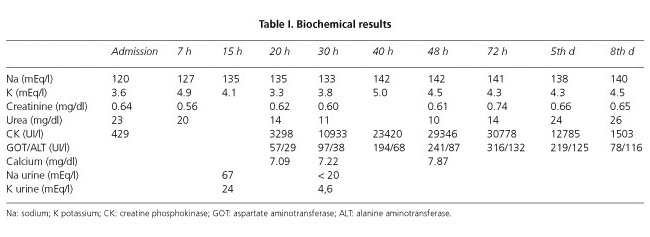Mi SciELO
Servicios Personalizados
Revista
Articulo
Indicadores
-
 Citado por SciELO
Citado por SciELO -
 Accesos
Accesos
Links relacionados
-
 Citado por Google
Citado por Google -
 Similares en
SciELO
Similares en
SciELO -
 Similares en Google
Similares en Google
Compartir
Revista Española de Enfermedades Digestivas
versión impresa ISSN 1130-0108
Rev. esp. enferm. dig. vol.105 no.3 Madrid mar. 2013
https://dx.doi.org/10.4321/S1130-01082013000300016
LETTERS TO THE EDITOR
Severe rhabdomyolysis and hyponatremia induced by picosulfate and bisacodyl during the preparation of colonoscopy
Rabdomiolisis e hiponatremia graves inducidas por picosulfato y bisacodilo durante la preparación para una colonoscopia
Key words: Hyponatremia. Rhabdomyolysis. Colonoscopy.
Palabras clave: Hiponatremia. Rabdomiolisis. Colonoscopia.
Dear Editor,
Colonoscopy is the most effective method for diagnosing colonic pathology. A proper laxative preparation is essential for an adequate evaluation, although it may be associated with serious side effects (1,2).
We report the case of a patient who presented a seizure due to hyponatremia associated with severe rhabdomyolysis.
Case report
A 57-year-old woman was admitted for a generalized tonic-clonic seizure. She had clinical history of hypothyroidism, migraine and hypercholesterolemia.
The patient was scheduled a colonoscopy for investigation of rectal tenesmus. Three days before she had initiated a bowel preparation based on a liquid diet. The day of admission, the patient had an elevated water intake and she had taken two sachets of CitraFleet® and two tablets of bisacodyl.
On examination, the patient presented temporal disorientation, indifferent right cutaneous plantar reflex and lack of neck stiffness or other alterations. Biochemical results are reported in Table I. The main findings were serum sodium of 120 mEq/l and an initial creatine phosphokinase (CK) levels of 429 IU/l that reached a maximum level of 30778 IU/l. Brain CT showed a small chronic infarction, and no other relevant findings.
Due to the presence of neurological symptoms, a 3 % saline infusion was initiated at a rate of 1.5 ml/kg/h. After two hours of treatment, sodium levels increased and neurological symptoms resolved and treatment was switched to a 0.9 % saline infusion. Regarding CK levels, they increased during the first 72 hours in spite of serum therapy and they gradually declined on the following days. Renal function was preserved throught the process.
Discussion
Bowel preparation is associated with serious side effects. Both, bisacodyl and picosulfate can cause abdominal pain and distension, thirst, vomiting or vertigo, and possibly they have a synergistic effect when administered in association.
Other undesirable effects are electrolyte disturbances, mainly hyponatremia, which is present in 7.5 % of patients (4). The development of hyponatremia is influenced by different factors: a) a raise in antidiuretic hormone secretion; b) increased water intake; and c) impaired free water clearence. Among them, the most important is the increase in antidiuretic hormone secretion which is stimulated by osmotic and non-osmotic factors (4,5). Thus, bowel preparation using both drugs should be avoided in patients with a history of diabetes insipidus, potomania, renal failure and those under diuretic therapy, as the risk of hyponatremia in these patients is specially increased.
On the other hand, rhabdomyolysis is a rare complication of hyponatremia that has been previously described in illicit drug users, psychogenic polydipsia or exercise-associated hyponatremia (6-9). It is also common its association with seizures (10). In the present case, CK levels were disproportionately high as to be justified only by hyponatremia or seizures, and are probably due to a synergistic effect of both conditions.
In conclusion, in patients with an increased risk of electrolyte disturbances, the risk-benefit of using a combination of bisacodyl and picosulfate for bowel preparation should be carefully evaluated.
Antonio Más1, Juan José Chillarón1, Erika Esteve2, Irene Navalpotro3 and August Supervía4
Departments of 1Endocrinology and Nutrition, 2Internal Medicine, 3Neurology, and 4Emergency. Parc de Salut Mar. Barcelona, Spain
References
1. Marín Gabriel JC, Rodríguez Muñoz S, de , Carretero Gómez JF, Muñoz Yagüe MT, Manzano Alonso ML, et al. Electrolytic disturbances and colonoscopy: bowel lavage solutions, age and procedure. Rev Esp Enferm Dig 2003;95:863-75. [ Links ]
2. Dillon CE, Laher MS. The rapid development of hyponatraemia and seizures in an elderly patient following sodium picosulfate/magnesium citrate (Picolax). Age Ageing 2009;38:487. [ Links ]
3. Runkle I, Villabona C, Navarro A, Pose A, Formiga F, Tejedor A et al. Algoritmo de tratamiento de de Nefrología-Sociedad Española de Endocrinología y Nutrición-Sociedad Española de Medicina Interna. Disponible en: http://www.seen.es/pdf/guias/otras/algoritmo-hiponatremia-2012.pdf. [ Links ]
4. Cohen CD, Keuneke C, Schiemann U, Schroppel B, Siegert S, Rascher W, et al. Hyponatraemia as a complication of colonoscopy. The Lancet 2001;357:282-3. [ Links ]
5. Tormey WP. Hyponatraemia after colonoscopy. The Lancet 2001; 357:1621-2. [ Links ]
6. Bennett M. Fitzpatrick G. Doneelly M. Rhabdomyolysis associated with polydipsia induced hyponatremia. BMJ Case Rep 2011;4;2011. [ Links ]
7. Sue YM, Lee YL, Huang JJ. Acute hyponatremia, seizure, and rhabdomyolysis after ecstasy use. J Toxicol Clin Toxicol 2002;40:931-2 [ Links ]
8. Putterman C, Levy L. Rubinger D. Transient exercise-induced water intoxication and rhabdomyolysis. Am J kidney Dis 1993;21:206-9. [ Links ]
9. Lara Aguayo P de, Morán Fernández E, Soriano Rodríguez F, Rojas Amezcua M, Aguilar Alonso E. Rhabdomyolysis secondary to hyponatraemia. Nefrologia 2011;31:500-2. [ Links ]
10. Os I. Lyngdal PT. General convulsions and rhabdomyolysis. Case reports. Acta Neurol Scand 1989;79:246-8. [ Links ]











 texto en
texto en 



